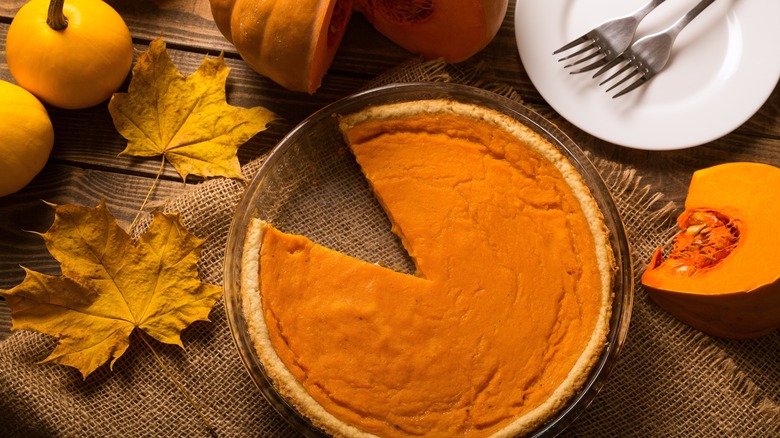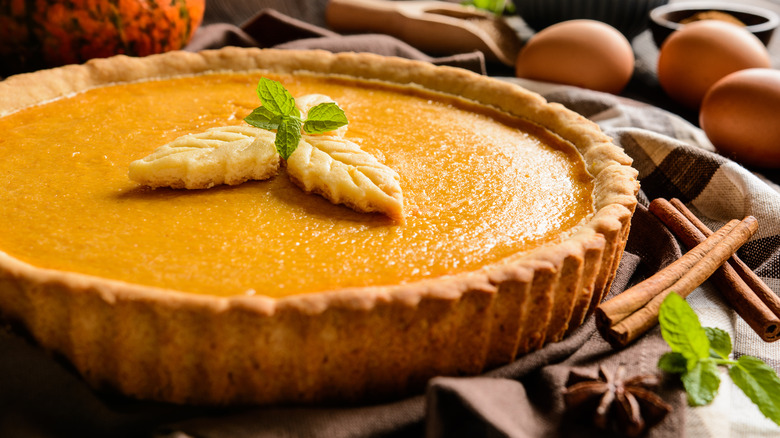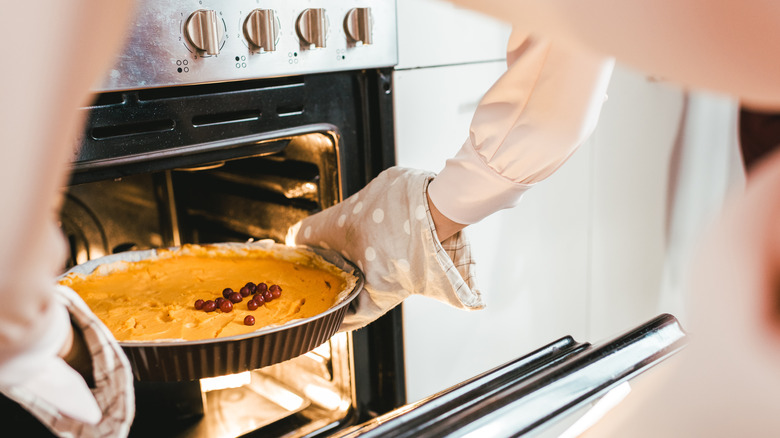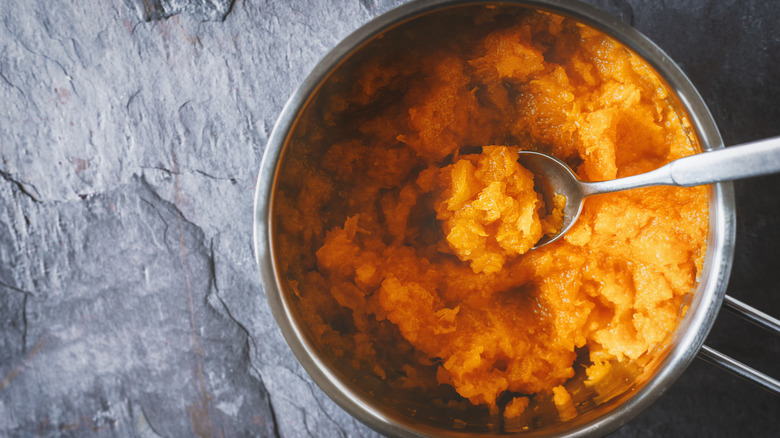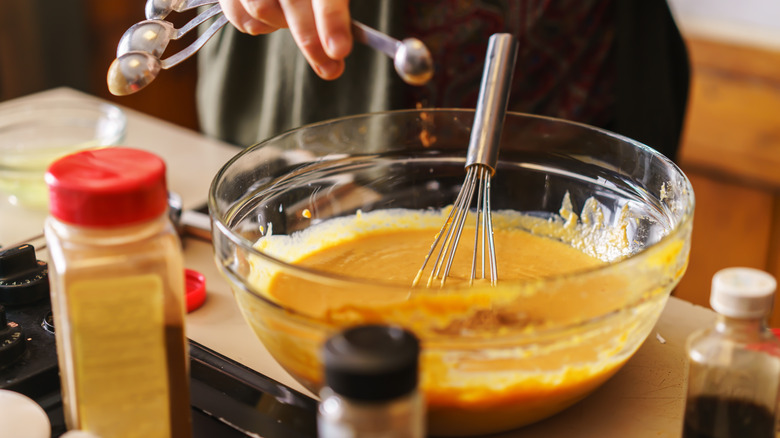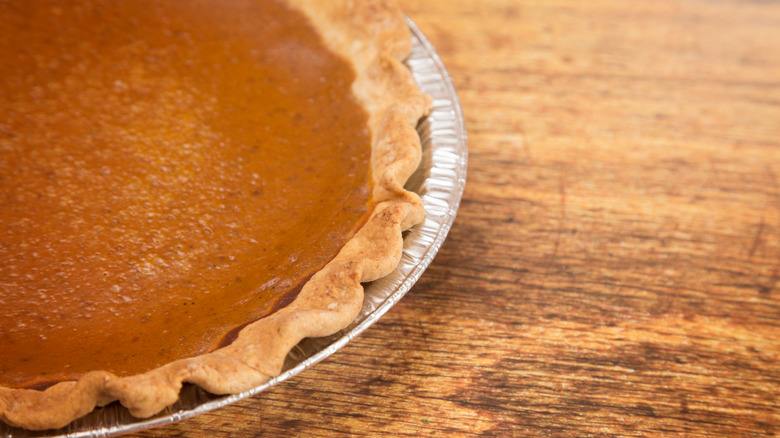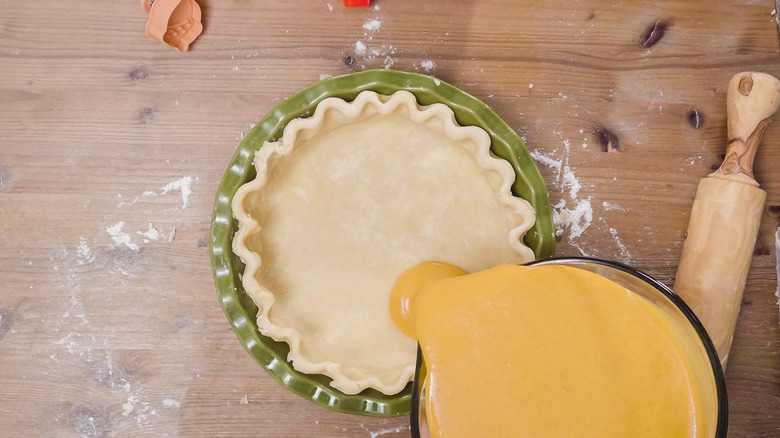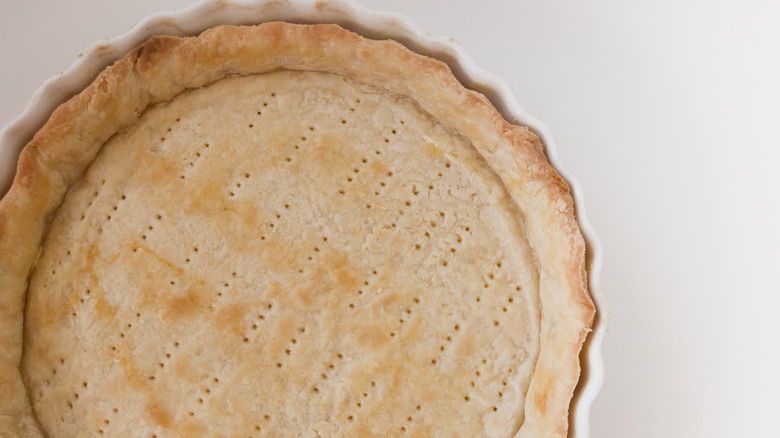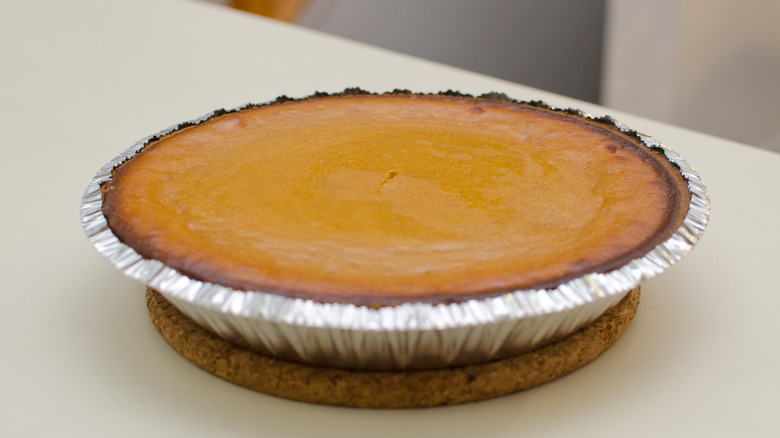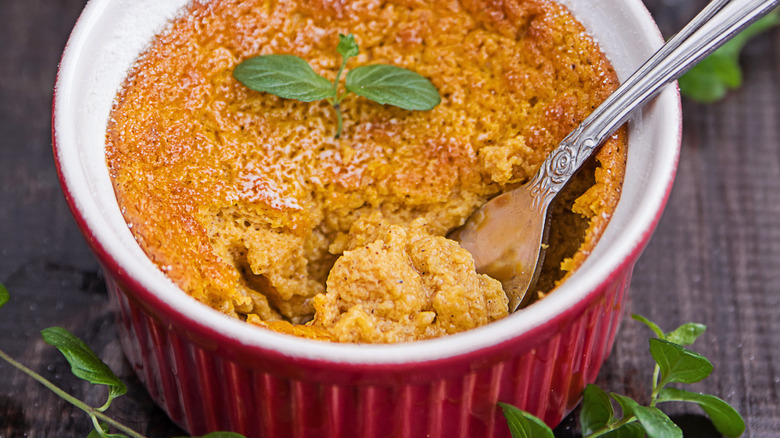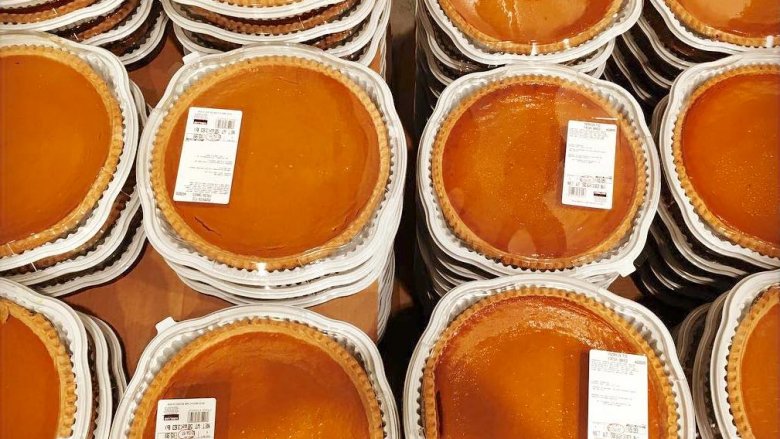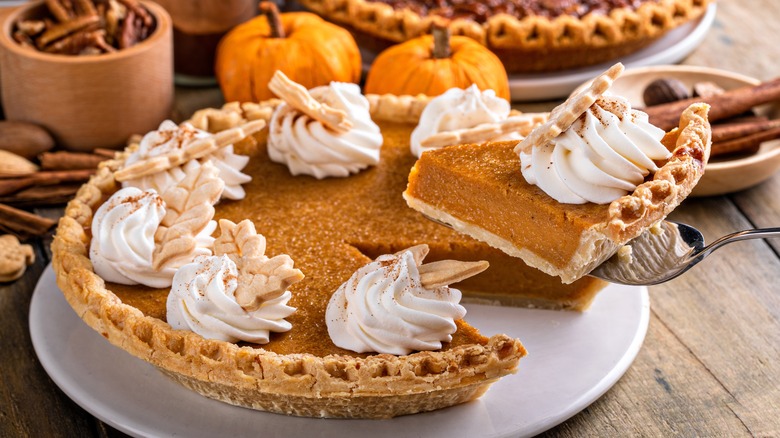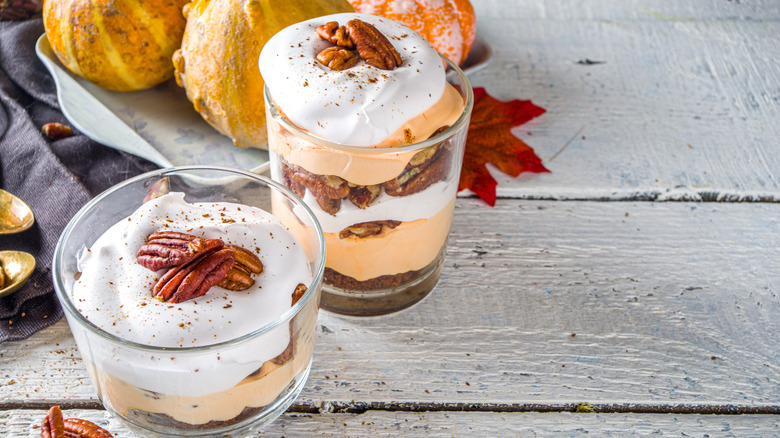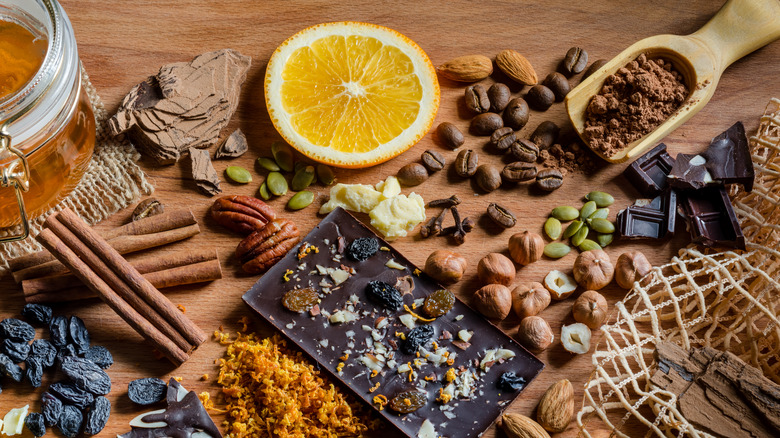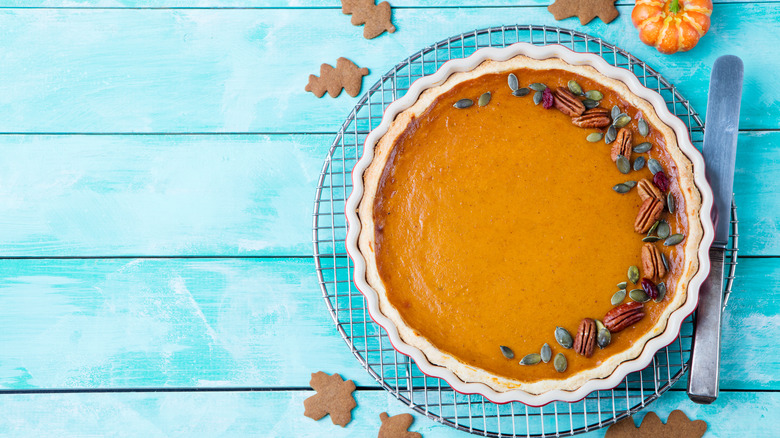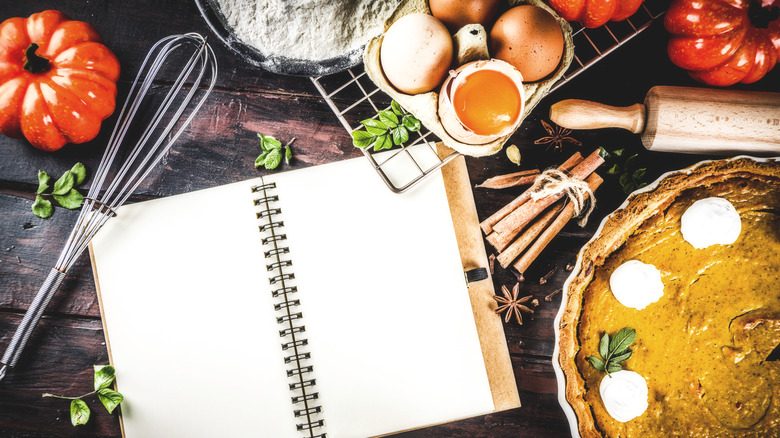Ways You're Screwing Up Your Pumpkin Pie
We may receive a commission on purchases made from links.
There's a whole lot of planning and preparation that goes into cooking Thanksgiving dinner, but unfortunately, even with all that prepping and planning, there's still a whole lot that can go wrong. From dried out turkey, to gluey mashed potatoes, to soggy stuffing, your feast can quickly go from gourmet to gross, dessert included. Yep, it turns out that there are plenty of ways you're probably screwing up your pumpkin pie.
Think making homemade pumpkin puree is better than using a can? Think again. If you're not careful, that homemade puree will lead you straight to a ruined pie. And what about those handy disposable pie tins you've been using for years? They're probably not the best choice if you want your pie baked to perfection. The good news is that although there is a lot that can go wrong, it's all avoidable, and worst case, most of these fails are even fixable. Hey, a can of whipped cream solves most problems, doesn't it?
You're making it weep
Have you ever noticed what looks like condensation on top of your baked pumpkin pie? Though you might logically think that this weepiness is a sign that your pie needs more time in the oven, it's actually an indicator that you've over-baked it. Specifically, the overcooked eggs in the custard filling are to blame.
Chowhound reports that Wayne Gisslen, author of Professional Baking, explains in his book, "an overbaked custard becomes watery because the moisture separates from the toughened protein." Unfortunately, you can't go back in time once you've over-baked your pie, but you can ensure the next one is just right by looking for a few telltale signs of doneness. When the center of the filling still has a bit of give, or "jiggle," it's time to take it out. (No jiggle would indicate an overcooked pie.) Also pay attention to the color of the filling — it will darken and puff up when it's close to done. And if you don't trust those methods, use the old standby: Insert a knife into the filling close to the crust. It should come out "moist but clean."
You're not using a thermometer
It turns out that weepiness isn't your only worry when it comes to overbaking. A cracked top is another common pumpkin pie problem, and it can seem like no matter how spot on we are with the timing, those cracks show up anyway. The solution? Use the most precise method of checking your pie's doneness: an instant read thermometer. We rely heavily on thermometers to yield the best results when we make candy or grill a chicken, so why wouldn't we use one on pie?
According to ThermoWorks, the perfect pull temperature of pumpkin pie is 175 F (tested at the center of the filling). This temperature ensures the egg mixture is set, but results in a silky texture, nary a crack in sight. The only problem, of course, is the hole that you've poked into the center of your finished pie, but it's nothing a dollop of whipped cream can't hide.
You're using homemade pumpkin puree
You're the hostess with the mostest and there is not a chance that you'll be grabbing a can of pumpkin puree when you could whip up a homemade batch. You go to your "From-scratch Thanksgiving" Pinterest board and get to work with those fresh pumpkins, because homemade pumpkin puree has to result in a superior pie, right? Wrong.
Bon Appétit cautions that homemade puree contains much more moisture than canned puree, and that extra wetness could lead to a soggy crust or a loose filling... probably not the results you're hoping for. But if you're a homemade-or-bust kind of pie maker, you'll just want to take a few steps to ensure you get as much moisture out of the puree as possible. For starters, instead of boiling the pumpkin, roast it in a low oven until softened but not browned. Then, once it's pureed, reduce the mixture on the stovetop until thickened.
Or, you know, skip all that and just open a can.
You're using pumpkin pie mix
Pumpkin pie mix is ideal when you need dessert in a hurry, but if you use it in a recipe that calls for pumpkin puree, your pie will suffer.
See, that can of pumpkin pie mix already has sugar, spices, and other ingredients included. If you use that in a recipe where you're adding more sugar and more spices, the flavor of the filling will be out of whack. Then there's the size issue. Pure pumpkin puree usually comes in both 15-ounce and 29-ounce cans, while pumpkin pie mix is sold in a 30 ounce can. If you grab that 30-ounce can of mix when your recipe calls for a smaller can (or something else entirely, no less), there's no telling what you'll end up with.
The bottom line is, pumpkin pie mix is fine, but not as a stand-in for pumpkin puree.
You're using disposable pie pans
We get it. After a long day of cooking, even one less dish to wash seems significant. But if you're taking the shortcut with disposable pie tins, you're probably not putting your best pie foot forward.
While the lightweight aluminum pans are definitely good for giving pies away, they're not so great for baking pies in, and that's because the thin metal doesn't transfer enough heat to allow the crust to bake as evenly as heavier pie plates. According to Cook's Illustrated, this will most certainly lead to soggy bottoms and undercooked sides. Because of this, they recommend glass pie plates which conduct heat evenly, and get bonus points due to the fact that you can actually see the color of your crust through the plate, eliminating any guesswork.
If you just can't quit the disposables, The Kitchn has a tip: Place the aluminum pie tin inside a glass pie plate, then bake as usual. The glass dish will transfer the heat more evenly through the aluminum and result in a better pie, and with any luck there won't be any spillage to clean up.
You're not blind baking
In your never-ending search for shortcuts, it might seem much more efficient to just pour the pumpkin filling into a raw pie crust and throw it in the oven to bake up all at once, but doing so is actually a roll of the dice. If you're okay with soggy bottom pumpkin pies, though, go right ahead and skip the blind baking.
Yes, it's an extra step and it takes a little longer, but blind baking is key to the success of your pumpkin pie. And it's not hard. When you blind bake a pie shell, you're simply cooking it before adding any filling. Just line the pie shell with parchment paper, fill it with dried beans to keep the dough from puffing, bake, and boom, you just cut your chances of a soggy pie way down.
One other tip to avoid the dreaded sog: Warm (not hot) pie filling. Warm filling sets faster than cold, which cuts down on the time the liquid sits on the crust, and also cuts down on baking time.
You suffer shrinkage
Now that we know the importance of blind baking, let's move on to all those other pie crust woes.
Shrunken crusts are a common problem. Things seem great when you put the pie dough into the oven, but for some reason, it's a shriveled up version of itself when you pull it out again. What gives? Shrinkage is a telltale sign that you are an impatient baker. If you don't let your pie dough rest in the refrigerator for at least 15 minutes before rolling it out, chances are very good that the unrelaxed gluten will seize up on you, producing that shrunken shell.
Then there's dry, crumbly crust. If you can't roll it out without it breaking into pieces, that's a sign that your dough needs water. But easy does it. A little at a time will prevent you from having to add more flour. You don't want to get into a vicious water-flour cycle.
And what about a tough, decidedly not flaky crust? That's the number one reason not to overwork your pie dough. The best pie crust is handled as minimally as possible.
You burn the crust every time
So you've followed all of our pie dough advice. You're off to a good start, but you're not quite out of the woods yet when it comes to a crust fail. Because it has already started to brown during its first stint in the oven while blind baking, the second go-round could lead to a blackened crust.
This one's easy. Once the crust has reached peak golden brown perfection, all you need to do is cover it — but make sure you're only covering the crust, not the entire pie. This is a snap if you have a handy pie crust shield, but even if you don't, it's no problem. Just grab some aluminum foil and make your own. Take a piece of foil large enough to cover the pie, and fold it into quarters. Now channel your inner third-grader and cut out a circle by rounding the outer edge and inner point. Lay the shield or foil circle over the pie to prevent further browning, and just like that, you've successfully avoided a pie crust fail.
You're a slave to the crust
Let's face it: Making perfect pie dough and baking the perfect crust can be a bit of a pain. Sure, you can buy pre-made crusts, but why not skip the crust altogether? 'Tis the season to focus on pumpkin, is it not?
Making a pumpkin custard is no different than making pumpkin pie filling — you're just omitting the crust. Grab some ramekins or other small oven-safe bowls and pour the filling in those to make individual custards. Baking time will vary depending on the size of the dish, but the same rules apply for doneness as with a pie. To ensure super creamy dreamy custard though, you'll want to use a water bath while baking. Don't worry, it's not complicated. Just place the ramekins in a larger oven safe baking dish, then pour hot water into the dish until it comes about halfway up the ramekins, and bake as usual. That's all there is to it.
You're not buying it
Now that you know all the ways you can screw up a homemade pumpkin pie, doesn't buying it just sound a whole lot easier than baking it?
The way we see it, you have two choices: You can painstakingly roll out pie dough that won't shrink up, that isn't too crumbly but also not too wet, and then blind bake that pie dough, and then make the filling, and then bake the filling to the just-right temperature so the pie isn't weepy or cracked. Or, option two, you can waltz into any grocery store and buy a perfectly good pumpkin pie for a few dollars, and then take it home and spend less than five minutes upgrading it. Think pumpkin pie brûlée, or boozy whipped cream, or a meringue top — all decidedly more delicious than an overbaked pie with a soggy crust. Given the options, the choice seems fairly obvious, no?
You're not experimenting with whipped cream
Whipped cream is necessary for good pumpkin pie — many think it might be more important than the pie itself. Fresh whipped cream is a matter of a few simple ingredients and a whisk or mixer. Whether you decorate your pie with whipped cream, use it to camouflage a cracked top, or dollop it on each slice as it's served, there's no doubt that whipped cream and pumpkin pie is a perfect match.
But what if you could improve perfection? Dedicated recipe browsers have seen endless additions and variations on pumpkin pie, from praline topping to flavoring the filling with chocolate, peanut butter, or Fireball whiskey. While we love experimenting in the kitchen, the holiday dessert table might not be where you want to start, and that's okay. A quicker solution? Keep Grandma's classic pumpkin pie recipe and flavor the whipped cream instead.
So many flavors can take the pumpkin to the next level: cinnamon, honey, chocolate, orange, ginger, caramel, maple, or even lemon. If you choose a sweet addition like honey, caramel, or maple syrup, omit the sugar and use it to sweeten basic whipped cream. Citrus zest, extracts, cocoa powder, and spices can be added to taste, and it's up to you whether they replace the vanilla or enhance its flavor. Cocktail bitters can add a sophisticated edge to whipped cream. And if you love decorating with flavored canned whipped cream, the holiday season is the time to look for them.
Improvise with an imperfect pie
Even the best cooks make mistakes. Pumpkin pie can be tricky, and we all have that super-judgy relative who loves giving unwanted advice. Maybe the crust burned, or there's a gigantic crack in the middle you can't hide, but stay calm. Before trashing the pie and heading to the bakery, use some creativity to save the pie and your sanity.
Forget boring pieces of pie; instead, rethink dessert and impress your guests with something unexpected. The beauty of this plan is that the new dessert will use chunks of pie, so you can get rid of any burned crust or anything unsavory without worrying about aesthetics. Adding a few extra ingredients will elevate the least appealing pie into a dessert everyone will devour.
Redditors love Dairy Queen's pumpkin pie Blizzard, so why not create your own? Blend vanilla ice cream and most of the pie into thick shakes, top with whipped cream, and garnish the tops with bite-sized pieces of pie. While we're thinking of pie and ice cream, a pumpkin pie sundae is a delicious way to conceal mistakes and will be a total crowd pleaser. Finally, as Donkey said in Shrek, "Everybody loves parfait!" Layering chunks of pumpkin pie with whipped cream, vanilla pudding, crumbled cookies, and pecans in beautiful glasses would make an impressive dessert display and leave everyone clamoring for more. Who knows? These desserts might end up replacing pumpkin pie for years to come at your Thanksgiving table.
You aren't flavoring the pie crust
There's no doubt that the crust can make or break any pie. No matter which pie crust method you use, whether you buy a crust or make it from scratch with butter, lard, or oil, it needs to be delicious and flaky, or the entire pie is a flop. However, there are ways to heighten the flavor and texture of your pumpkin pie that many home cooks never consider.
Adding spices, citrus zest, extracts, nuts, cookie crumbs, or cocoa powder to your pie crust will add layers of flavor to pumpkin pie that will excite your taste buds and leave your guests in awe of your baking prowess. Remember, a little goes a long way; you want to boost the flavor, but pumpkin should still be the star ingredient. Shortbread crumbs add extra buttery sweetness, while cinnamon and a bit of sugar (or any combination of pumpkin pie spices) complement the pumpkin filling beautifully.
Use cocoa powder instead of a tablespoon or two of the flour in your crust recipe for a decadent crust that will completely revamp pumpkin pie. Use lemon zest to brighten the pastry's flavor, or, if you'd like crunch and sweetness, try crushed pecans, graham crackers, gingersnaps, or chocolate biscuits. There are endless possibilities depending on your preferences, but a flavored pie crust will make your pumpkin pie unforgettable.
You're serving it before it's completely cool
Debates rage over the best serving temperature for pumpkin pie, and we all have an opinion. Many prefer pumpkin pie cold to keep whipped cream firmly on top, while some insist that warm pie makes pumpkin spices more flavorful. Others refuse to take a side, serving it at room temperature. Your pie, your opinion — but make sure to properly cool pumpkin pie before slicing it.
Why does pumpkin pie need cooling time? First, ensure the pie is cooked. Since the oven's heat continues to cook the custard after the pie comes out, cooling time is crucial. It should sit undisturbed for at least 30 minutes, or up to two hours. Secondly, letting pumpkin pie cool allows the custard to set up correctly. Nobody wants a runny mess that won't hold its shape.
Now that you understand why the pie needs to cool, you can decide how to proceed. You have it made if you enjoy cold or room temperature pumpkin pie. Make the pie whenever it's convenient and store it covered in the refrigerator. Bring it out about an hour before dessert if you choose to serve room temperature pie. Those that prefer a warm, creamy center should let the pie get to room temperature, then protect the crust from burning before reheating in the oven for 10-15 minutes.
You're using too many eggs
Many people see cooking as a creative outlet, and dedicated home cooks often improvise with ingredients and spices to suit their tastes or what they have at hand. Experimenting with flavor and textures is always a good thing for food — except in the case of baking, where the first rule is to follow recipes without fail.
Pumpkin pie filling is a custard; it uses eggs to thicken and set the filling. Eggs can cause several common mishaps with pumpkin pie filling; the wrong number of eggs can make the filling soupy even before considering any bake-time issues, notes Insider.
Pumpkin pie isn't too hard to master, so it's easy to wonder when it goes wrong, especially if you believe you followed the recipe. Recipes can be deceiving regarding eggs, however. Eggs are sold according to size, and most recipes in the U.S. assume you are using large chicken eggs. For each extra-large or jumbo egg you use, you're adding up to an extra half-ounce of egg to the filling, says Sauder's Eggs, affecting your pumpkin pie. Since a perfect pumpkin pie relies on the fat in the yolk to thicken the custard and provide a rich texture and relies on the whites for the filling's structure, getting the proportions exactly right is critical. For an exquisitely tasty pumpkin pie, follow the recipe precisely, including which size eggs it calls for.
